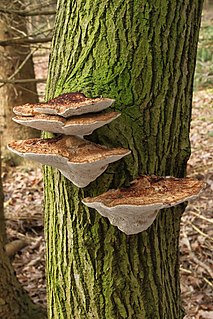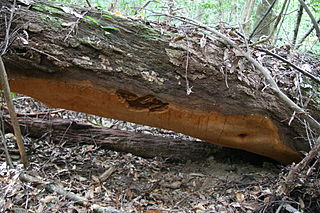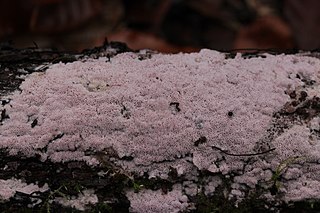
Daedaleopsis confragosa, commonly known as the thin walled maze polypore or the blushing bracket, is a species of polypore fungus in the family Polyporaceae. A plant pathogen, it causes a white rot of injured hardwoods, especially willows. The fruit bodies are semicircular and tough, have a concentrically zoned brownish upper surface, and measure up to 20 cm (8 in) in diameter. The whitish underside turns gray-brown as the fruit body ages, but bruises pink or red. It is found all year and is common in northern temperate woodlands of eastern North America, Europe, and Asia. The species was first described from Europe in 1791 as a form of Boletus, and has undergone several changes of genus in its taxonomic history. It acquired its current name when Joseph Schröter transferred it to Daedaleopsis in 1888.

The Meruliaceae are a family of fungi in the order Polyporales. According to a 2008 estimate, the family contains 47 genera and 420 species. As of April 2018, Index Fungorum accepts 645 species in the family.

Daedaleopsis is a genus of fungi in the family Polyporaceae. The name Daedaleopsis is a reference to Daedalus, the labyrinth-maker of myth. Similarly, the maze-like pattern of pores is taxonomically described as being daedaloid. DNA was recovered and sequenced from fragments of a nearly 7000-year-old fruit body of D. tricolor found in an early Neolithic village in Rome.
Grammothelopsis is a fungal genus in the family Polyporaceae. It was circumscribed in 1982 by Swiss mycologist Walter Jülich, with Grammothelopsis macrospora as the type species.

Skeletocutis is a genus of about 40 species of poroid fungi in the family Polyporaceae. The genus has a cosmopolitan distribution, although most species are found in the Northern Hemisphere. It causes a white rot in a diverse array of woody substrates, and the fruit bodies grow as a crust on the surface of the decaying wood. Sometimes the edges of the crust are turned outward to form rudimentary bracket-like caps.

Phellinus ellipsoideus is a species of polypore fungus in the family Hymenochaetaceae, a specimen of which produced the largest fungal fruit body ever recorded. Found in China, the fruit bodies produced by the species are brown, woody basidiocarps that grow on dead wood, where the fungus feeds as a saprotroph. The basidiocarps are perennial, allowing them to grow very large under favourable circumstances. They are resupinate, measuring 30 centimetres (12 in) or more in length, though typically extending less than a centimetre from the surface of the wood. P. ellipsoideus produces distinct ellipsoidal spores, after which it is named, and unusual setae. These two features allow it to be readily differentiated microscopically from other, similar species. Chemical compounds isolated from the species include several steroidal compounds. These may have pharmacological applications, but further research is needed.
Skeletocutis bambusicola is a species of poroid crust fungus in the family Polyporaceae. It was described as new to science in 2012 by mycologists Li-Wei Zhou and Wen-Min Qin. It is found in southern China, where it grows on dead bamboo. The type collection was made in Mengla County, Yunnan Province. The specific epithet bambusicola refers to its growth on bamboo. At the time of publication, S. bambusicola was the 22nd Skeletocutis species recorded from China.

Nigroporus vinosus is a species of poroid fungus in the family Steccherinaceae, and the type species of the genus Nigroporus. Its fruit bodies have brownish caps with tinges of purple or red. The cap underside has a pore surface the same colour as the cap, and minute pores. Nigroporus vinosus has a pantropical distribution. It has been recorded from Africa, North America, Central America, South America, Asia, and Oceania. It is a wood-decay fungus that causes a white rot.
Fibroporia albicans is a species of poroid crust fungus in the family Fomitopsidaceae. It causes a brown rot. The fungus was described in 2015 as a species new to science, based on collections made in Jiangxi and Xizang Provinces, China. It is one of five Fibroporia species recorded in China.

Skeletocutis carneogrisea is a species of poroid crust fungus in the family Polyporaceae. It was described as new to science by Alix David in 1982. It is found in Europe, South America, and China.
Skeletocutis yunnanensis is a species of poroid crust fungus in the family Polyporaceae that was described as a new species in 2016. The type specimen was collected in northern Yunnan Province, southwestern China, where it was found growing on decaying angiosperm wood in a temperate forest.
Megasporoporia minor is a species of crust fungus in the family Polyporaceae. Found in China, it was described as a new species in 2013 by mycologists Bao-Kai Cui and Hai-Jiao Li. The type was collected was made in Daweishan Forest Park, Yunnan, where it was found growing on a fallen angiosperm branch. It is distinguished from other species of Megasporoporia by its relatively small pores and small spores ; it is these features for which the fungus is named.
Megasporoporia bannaensis is a species of white rot crust fungus in the family Polyporaceae. Found in China, it was described as a new species in 2013 by mycologists Bao-Kai Cui and Hai-Jiao Li. The type was collected in Sanchahe Nature Reserve, Yunnan, where it was found growing on a fallen angiosperm branch. It is characterized by its relatively large pores, the unbranched skeletal hyphae, and long, thin hyphal plugs in the hymenium. Its spores measure 10–14 by 3.9–4.6 μm. The specific epithet bannaensis refers to the type locality (Xishuang-Banna).
Postia cylindrica is a species of poroid fungus in the family Fomitopsidaceae. Found in Southern China, it was described as a new species in 2017 by Hai-Sheng Yuan. The type collection was found growing on a dead pine tree in Jiangxi. The fungus is characterized macroscopically by crust-like to effused-reflexed fruit bodies with a cream to buff coloured cap surface and a reddish-brown margin that curves inward. There are gloeoplerous (oily) hyphal cells in the cuticular layer, and an absence of cystidia in the hymenium. The fungus produces smooth, cylindrical, thin-walled spores measuring 4.7–5.2 by 1.3–1.5 μm.
Luteoporia is a fungal genus in the family Meruliaceae. It is monotypic, containing the single white rot species Luteoporia albomarginata, found in China. Macroscopic characterics of this fungus include its annual growth habit, and crust-like fruit bodies with yellow pores. Microscopic characteristics include a monomitic hyphal system with clamp connections, hyphae in the trama featuring swollen tips projecting out of the hymenium, and spores that are hyaline, thin-walled, and oblong-ellipsoid. The type collection was made in Wuzhishan Nature Reserve, where it was found growing on rotten angiosperm wood. The generic name Luteoporia refers to the yellow pore surface, while the specific epithet albomarginata refers to the white margin of the fruit body.
Datroniella tropica is a species of crust fungus in the family Polyporaceae. Found in southwestern China, it was described as a new species in 2014 by mycologists Bao-Kai Cui, Hai J. Lee, and Yu-Cheng Dai, who placed it in the new genus Datroniella. The type collection was made in Tongbiguan Nature Reserve, where the fungus was found growing on a fallen angiosperm branch. The specific epithet tropica refers to its distribution in tropical China.
Dentocorticium hyphopaxillosum is a species of crust fungus in the family Polyporaceae. It is found in the Guangxi Autonomous Region of southern China, where it grows on fallen angiosperm branches. It was first described in 2014 as Dendrodontia hyphopaxillosa by mycologists Meng-Jie Li and Hai-Sheng Yuan, who thought it was related to other species of Dendrodontia based on morphological characteristics. It was transferred to the genus Dentocorticium in 2018 based on phylogenetic analysis; Dendrodontia was synonymized with Dentocorticium. Characteristics of D. hyphopaxillosum include its crust-like fruit bodies, cylindrical hyphal pegs, contorted dendrohyphidia that are frequently branched, and spores with an ellipsoid to somewhat cylindrical shape.

Ceriporia excelsa is a species of crust fungus in the family Irpicaceae. It is found in Europe and North America, where it typically grows on dead hardwood. It has also been recorded from China.
Perenniporia meridionalis is a poroid crust fungus in the family Polyporaceae. It was described as a new species by Cony Decock and Joost Stalpers in 2006. The holotype specimen was collected in the Province of Nuoro in Italy, where it was found growing on dead wood of Quercus ilex. Distinguishing characteristics of this fungus include its relatively large pores, the hyaline vegetative hyphae that are yellowish to slightly dextrinoid in Melzer's reagent, and large spores measuring 6.0–7.7 by 4.5–6.2 µm. P. meridionalis occurs in central and southern Europe, where it is found in warmer forested areas, usually on dead oak wood. It has also been reported to occur in North America.
Perenniporia puerensis is a poroid crust fungus in the family Polyporaceae. Found in Yunnan, China, it was described as a new species in 2017. The crust-like fruit body of the fungus have a yellow to ochraceous pore surface, with 4 to 6 pores per millimetre. P. puerensis has a dimitic hyphal system with non-dextrinoid and cyanophilous skeletal hyphae that are encrusted with pale-yellow crystals. The spores are egg-shaped to somewhat spherical, thick-walled, non-dextrinoid, and cyanophilous, with dimensions of 4.3–5.5 by 3.7–4.7 µm.







